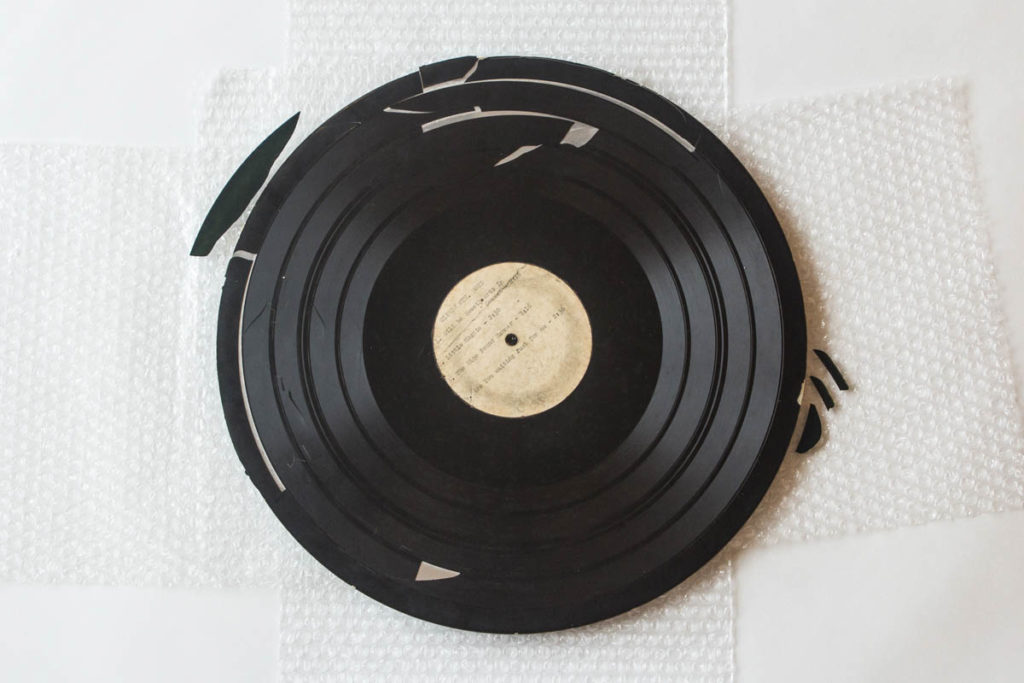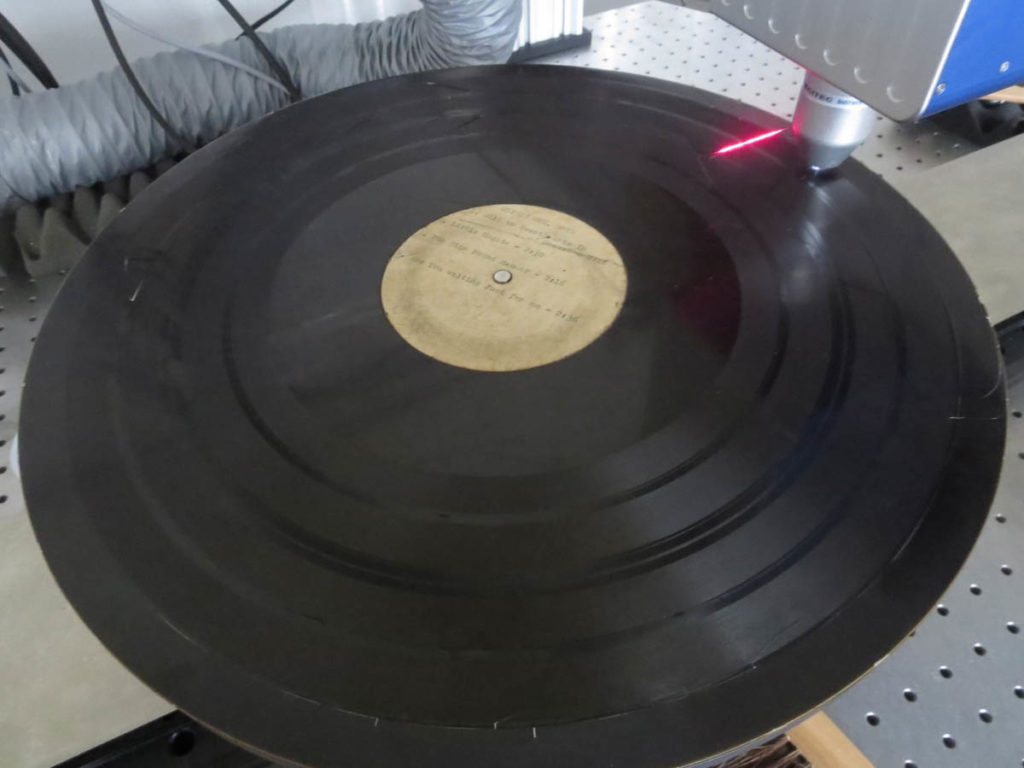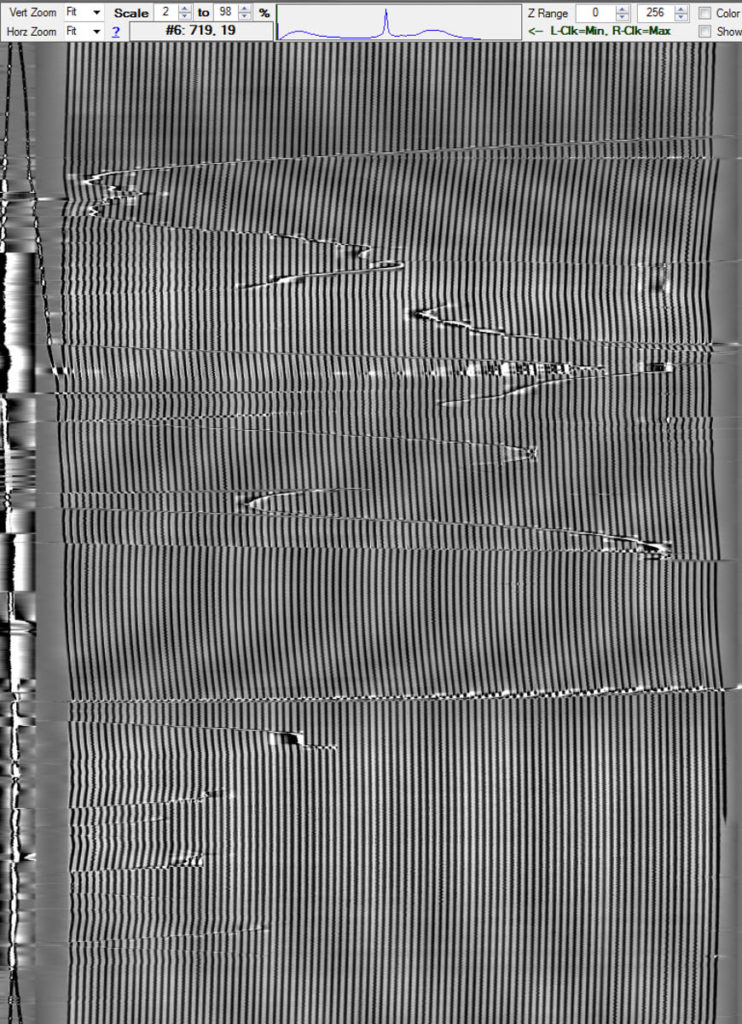At the Northeast Document Conservation Center (NEDCC) in Andover, Massachusetts, we recently completed an especially rewarding project for the Birthplace of Country Music Museum. The museum honored us with the task of recovering nine previously unheard, live recorded songs performed by The Stanley Brothers & The Clinch Mountain Boys on the Farm and Fun Time radio show, circa 1950, from a damaged transcription disc – a project supported by the Virginia Association of Museums’ “Virginia’s Top 10 Endangered Artifacts” in 2018.
We were so thrilled to be a part of this project for two reasons in particular. One, despite our northern orientation, The Stanley Brothers happen to have quite a fan base here! And two, we always welcome a challenge, and this disc delivered.

The damage seen on the disc in the image above is called delamination, and it means the grooved lacquer coating is separating from the aluminum base. Any missing piece of the lacquer is a loss of the audio content. Additionally, a delaminating disc cannot safely be played with a stylus because the physical contact will cause further damage.
Therefore, in order to safely retrieve the audio from the disc, we used a non-contact, optical-scanning technology called IRENE. With IRENE, we take microscopic images of the grooves, and those images are analyzed in software to produce an audio file. The concept is fairly simple, but the process can be challenging for damaged media like this.
First, we carefully “puzzled” the separated pieces of lacquer back together on the disc. We did this by lining up the grooves as best as possible, without touching the grooved surface. The added challenge here is that delamination occurs with a loss of plasticizer. The lacquer becomes brittle, shrinks, and can warp. This means that the grooves won’t be perfectly aligned. A slight offset of the grooves might not seem dramatic to the human eye, but on a microscopic level (which you can see in the images), the disruptions can be quite dizzying.
After puzzling, we imaged the disc with a Precitek CHRocodile CLS Confocal Microscope. This “camera” captures the horizontal motion of the grooves by measuring the groove’s depth. The disc is carefully mounted on a platter that rotates beneath the camera as the grooves are imaged. The image resolution is based on the disc’s original recording speed and the desired specifications for the resulting audio file. Other factors, such as the disc’s reflectivity and surface wear, dictate other imaging parameters – like the optical sampling rate and exposure.

The process creates a high-resolution TIFF image file of the surface of the disc, where you can see the extent of the damage and misaligned grooves due to delamination:

One of the biggest challenges for us is getting the software – called Weaver – to follow the correct path of the groove as it shifts along the breaks. To enable this software to properly track the grooves on delaminating discs like this, we painstakingly plot the trajectory of the groove in a process called manual tracking. With proper tracking enabled, Weaver can mimic the motion of a stylus through the grooves to produce an audio file.
Weaver is a modular program built on a series of plug-ins, and our work involves selecting and adjusting settings within a set-of plug-ins. Each plug-in enables or performs a different analysis function to produce audio. For example, the VerticalFlip plug-in flips the image. This was necessary because these discs were originally recorded from the inside-out, and our cameras are only configured to scan in one direction. Flipping the image and then reversing the resulting audio file gives us the same results if we had played the record from the inside as it was originally intended. A series of tools like this allow us to manipulate the images in a variety of ways to accommodate different types of media and the unique damage they may have incurred during their lifetime.

Our goal is to produce a digital file that most accurately represents the audio on this disc in its current condition. On damaged discs like this, there can be brief moments where the audio drops out due to a missing piece of lacquer. Though there is some damage on the Farm and Fun Time disc, the “raw” audio from the Weaver software is remarkably listenable. And the true measure of success for this project: it’s also danceable!
In addition to the raw audio, we created separate listening copies for this project that have been processed with historically-accurate playback equalization and some restoration work to reduce the noise and to get rid of the clicks and pops. Though this process is subjective, we did our best to respect the content. The “cleaned-up” audio is more listenable but still reminds us of the disc’s condition and the music’s place in history.
The quality of the original recording plays a large role in the fidelity of the audio we’re able to capture. In this case, it probably helps that the recording took place in a studio with professional audio engineers. And the musicians were pros too – they knew how to approach the microphone when it was their time to sing or take a solo.
Here’s a short clip to get a sense of the result:
That we were able to image the disc before it incurred any further delamination or other damage was also critical for the quality of the resulting audio. Lacquer-coated instantaneous discs are some of the most inherently fragile formats in archival collections. Delamination is one of the major preservation threats, and it can progress relatively quickly.
The museum is owed much appreciation for their efforts to save the disc before it was too late, and we’re grateful to have had the opportunity to help preserve this audio treasure! And for your chance to hear the first reveal of the songs from this rescued disc, be sure to attend the live Farm and Fun Time show in the museum’s Performance Theater on February 13 or listen online via Radio Bristol’s Facebook page!
You can learn more about the Birthplace of Country Music Museum’s valiant efforts to save the disc, including how the disc was carefully packaged and transported to NEDCC, here. You can learn more about IRENE at NEDCC here.


